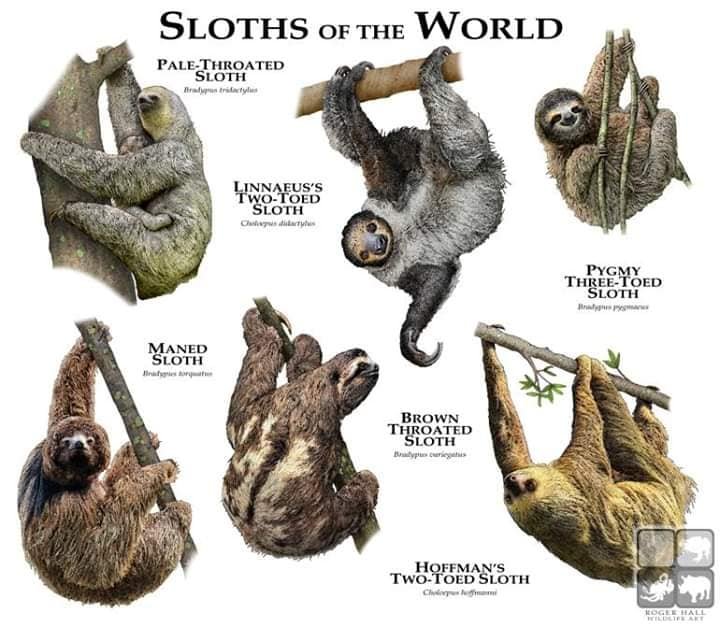
Order Pilosa - Sloths
Sloths are a group of arboreal Neotropical xenarthran mammals constituting the suborder Folivora. Noted for their slowness of movement, they spend most of their lives hanging upside down in the trees of the tropical rainforests of South America and Central America. They are considered to be most closely related to anteaters, together making up the xenarthran order Pilosa.
There are six extant sloth species in two genera – Bradypus (three–toed sloths) and Choloepus (two–toed sloths). Despite this traditional naming, all sloths have three toes on each rear limb-- although two-toed sloths have only two digits on each forelimb. The two groups of sloths are from different, distantly related families, and are thought to have evolved their morphology via parallel evolution from terrestrial ancestors.
Link to Mammal Galleries
The below images have links to the species shown. Brown-throated and Hoffman’s Two-toed Sloths have galleries on this page:
Brown-throated Sloth (Bradypus variegatus)
The Brown-throated Sloth (Bradypus variegatus) is a species of three-toed sloth found in the Neotropical realm of Central and South America. It is the most common of the four species of three-toed sloth, and is found in the forests of South and Central America.
The brown-throated sloth is of similar size and build to most other species of three-toed sloths, with both males and females being 42 to 80 cm (17 to 31 in) in total body length. The tail is relatively short, only 2.5 to 9 cm (1.0 to 3.5 in) long. Adults weigh from 2.25 to 6.3 kg (5.0 to 13.9 lb), with no significant size difference between males and females. Each foot has three fingers, ending in long, curved claws, which are 7 to 8 cm (2.8 to 3.1 in) long on the fore feet, and 5 to 5.5 cm (2.0 to 2.2 in) on the hind feet.
The head is rounded, with a blunt nose and inconspicuous ears. As with other sloths, the brown-throated sloth has no incisor or canine teeth, and the cheek teeth are simple and peg-like. They have no gall bladder, cecum, or appendix.
The brown-throated sloth has grayish-brown to beige-color fur over the body, with darker brown fur on the throat, the sides of the face, and the forehead. The face is generally paler in color, with a stripe of very dark fur running beneath the eyes.
The guard hairs are very coarse and stiff, and overlie a much softer layer of dense under-fur. The hairs are unusual in lacking a central medulla, and have numerous microscopic cracks across their surfaces. These cracks are host to a number of commensal species of algae, including Rufusia pillicola, Dictyococcus bradypodis, and Chlorococcum choloepodis. The algae are generally absent in the hair of young sloths, and may also be absent in particularly old individuals, where the outer cuticle of the hair has been lost. Sloth hair also harbours a rich fungal flora. Certain strains of fungi that grow on brown-throated sloth fur have been shown to possess anti-parasitic, anti-cancer, and anti-bacterial qualities.
Over parts of its range, the brown-throated sloth overlaps the range of Hoffmann's two-toed sloth. Where this overlap occurs, the three-toed sloth tends to be smaller and more numerous than its relative, being more active in moving through the forest and maintaining more diurnal activity.
The brown-throated sloth is the most widespread and common of the three-toed sloths. It is found from Honduras in the north, through Nicaragua, Costa Rica and Panama into Venezuela, Colombia, Ecuador, Bolivia, Brazil and eastern Peru. It is probably not found immediately north of the Amazon Rainforest or east of the Rio Negro, although its similarity to the pale-throated sloth found in these regions has led to some confusion in the past.
It is found in many different kinds of environments, including evergreen and dry forests and in highly perturbed natural areas. It is generally found from sea level to 1,200 m (3,900 ft), although some individuals have been reported from much higher elevations
Bradypus variegatus - seen in Panama’s Interior



Hoffmann's Two-toed Sloth (Choloepus hoffmanni)
Hoffmann's Two-toed Sloth (Choloepus hoffmanni), also known as the northern two-toed sloth is a species of sloth from Central and South America.
It is a solitary, largely nocturnal and arboreal animal, found in mature and secondary rainforests and deciduous forests. The common name commemorates the German naturalist Karl Hoffmann.
Hoffmann's two-toed sloth inhabits tropical forests from sea level to 3,300 m (10,800 ft) above sea level. It is found in the rainforest canopy in two separate regions of Central and South America, separated by the Andes. One population is found from eastern Honduras in the north to western Ecuador in the south, and the other in eastern Peru, western Brazil, and northern Bolivia. Based on cytochrome c oxidase subunit I sequences, a divergence date of about 7 million years between these populations has been suggested. Two-toed sloths live in the canopies in the forests of the tropical rainforests. They usually tend to be relaxing in the branches of the trees that are intertwined within each other throughout the sheltering treetops. Most of the two-toed sloths activity takes place hanging upside down but when it comes time for urination and defecation they make their way to the ground. These creatures also come to the ground when in need of a new tree to live upon or to discover a new food source
The five recognised subspecies of C. hoffmanni are:
C. h. hoffmanni, Peters, 1858 – Honduras, Nicaragua, Costa Rica, Panama
C. h. agustinus, Allen, 1913 – Venezuela, western Colombia, northern Ecuador
C. h. capitalis, Allen, 1913 – western Ecuador
C. h. juruanus, Lönnberg, 1942 – Brazil, Bolivia, extreme eastern Peru
C. h. pallescens, Lönnberg, 1928 – Peru
Hoffman’s Two-toed Sloths (Choloepus hoffmanni hoffmanni) Near Panama City
















